US forest climate assistance: An assessment
-----------------
Almost three years ago, the United States launched a major effort to help tropical forest nations dramatically reduce deforestation, one of the primary sources of climate pollution. This report assesses the progress made implementing this program and offers concrete recommendations for reform. By and large, the United States has done a good job getting the new REDD+ program (reducing emissions from deforestation and forest degradation) off the ground. The US government has significantly ramped up funding and will come close to meeting its international commitments in this area. It is helping to create the institutions, standards, knowledge, and new practices necessary for large-scale deforestation reductions. It is also making important contributions to several forested developing countries as they build national-level forest policies and capacity for better forest and land management.
 A few gaps between the program’s objectives and their implementation can and should be corrected, most notably that: reducing deforestation is not yet a major consideration for other US development assistance programs, such as those related to food security and agriculture, and it should be; U.S. efforts have been limited to foreign assistance and diplomacy, with little contribution from trade, agriculture, finance, and commerce agencies, even though global trade in agricultural commodities is the biggest cause of deforestation; and despite progress planning and building capacity for later reductions in deforestation, too little investment has been made in large-scale partnerships with top deforesting nations to reverse deforestation now.
A few gaps between the program’s objectives and their implementation can and should be corrected, most notably that: reducing deforestation is not yet a major consideration for other US development assistance programs, such as those related to food security and agriculture, and it should be; U.S. efforts have been limited to foreign assistance and diplomacy, with little contribution from trade, agriculture, finance, and commerce agencies, even though global trade in agricultural commodities is the biggest cause of deforestation; and despite progress planning and building capacity for later reductions in deforestation, too little investment has been made in large-scale partnerships with top deforesting nations to reverse deforestation now.
---------------

